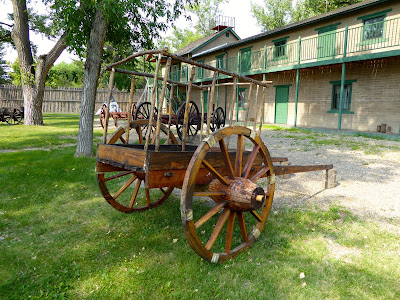EXPLORING GREAT FALLS AND FORT BENTON, MONTANA
August 3-6, 2015
Great Falls to the northeast of Helena brought a beautiful
red sunset.
Charles M. Russell, the famous cowboy American western frontier
artist, home site and adjacent art studio is a places not to miss.
The
Lewis & Clark National Historic Trail Interpretive Center in Great Falls gives
a splendid overview of the 1803-1805 Corps of Discovery’s Expedition which
Thomas Jefferson commissioned. Visitors are able to get the whole story through
interesting displays, insightful interpretation, and top-notch signage (often a
weak point in museums). The city of Great Falls got its name
when the Lewis and Clark expedition came upon five falls along the Upper
Missouri River for 18miles in the area forcing them to do a horrendous portage
hauling all their supplies overland for 11 day bypassing the falls.
Exploring the Lewis and Clark Interpretative Center set
the stage for our journey eastward across Montana. Following the Corps of
Discovery 1803-1805 Expedition’s trail along the Missouri River which mapped
the great expansion of the American western frontier has been our route.
We’ve
learned about Lewis’s big black Newfoundland dog named Seaman that accompanied
the expedition and Sacagawea’s
role was that of an interpreter and not a guide as some may have believed.
Along the Upper Missouri River Breaks exploring the quaint
little town of Fort Benton is another delightful place to visit. The Heritage Complex
area boists a wealth of a dozen old historic buildings, museums, and a
renovated old fort worth seeing. We spent a perfect day and a half walking
around Fort Benton at the Museum, the Old Fort, Upper Missouri Breaks National
Monument Interpretative Center, Homestead Village and Agriculture Museum.
Hearing stories about scamps and scalawags, Blackfoot Indians and buffalo, fur
trade and whiskey, steamboat and keelboat, the Gold Rush, bull whackers and
brothels, lawmen and outlaws, cowboys and homesteaders was a hoot. The museum
displays were full of fascinating lore, memorabilia and old photos portraying
the history of Fort Benton as it existed in the past. There is a warm charming
sense of feeling which puts you right smack in the heart of small town America.
Strangers stop and say hello, folks leave their doors unlocked and everyone
knows everyone passing along the street.
At the renovated Old Fort Benton in the trade room Captain
Mike greets visitors.
He is an authentic mountain man true to character in every
aspect from his dress attire, speech, conversation, mannerism to even
skippering a boat on the Upper Missouri Breaks and through the passage of the
white cliffs to the fork of the confluence at the Marias River and Missouri
River). He explains how the Blackfoot tribe brought buffalo robes to the fort
as the main exchange for trade whiskey, metal pots, beads, and blankets.
Eventually the Canadian Mounties received their payroll from Fort Benton and
stopped the trade whiskey run ending the buffalo robe trade around 1859.
Steamboats traveled and brought passengers and supply goods to the fort as the
last stop along the end of the Upper Missouri Breaks with steep cliffs, rocky
outcrops, and grassy plains.
Taking a short stroll along
the river walk visitors can step back in time at the Grand Hotel. The lobby desk
is in the huge front room of the hotel where folks in the wild old west days
would sit and watch the wild and rowdy cowboys riding their horses on the main
street. There is a place where a hotel employee back in those days would sit
with his shotgun just above the main staircase in the lobby to keep unruly
guests in check. One of the cowboys got past him and rode his horse up the main
staircase according to the desk clerk it is told. For anyone traveling across
Montana seeing Fort Benton is a must do for a gem destination.
Capturing a
sunset over the Missouri River water will be an incredible and awesome sight
too.











